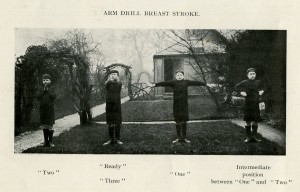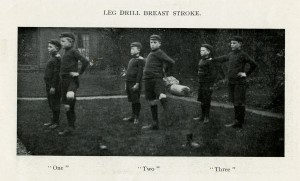One of my favourite documents in our collection is about swimming. Within the records of the children’s homes that were run by The Children’s Society, there are a number of documents that mention physical exercise. This suggests that exercise was something that the children in the homes were encouraged to participate in.
The boys living at St Mark’s Home for Boys in Natland, Cumbria, in the early-20th Century were known for swimming, and a number of boys from the home had been awarded swimming certificates by the Royal Life Saving Society.
The secret of St Mark’s Home’s swimming success was down to the way the boys were taught to swim. In fact, their method was seen as so effective that the home published a manual for other swimming instructors to learn from.
St Mark’s Home was three miles away from the local swimming pool, which meant that they weren’t able to use the pool very often. Instead, they decided on a method of teaching that may seem unusual to us now. The swimming manual states:
The method now adopted is to instruct and drill our beginners in class on land until they are at home with every position and movement for breast stroke, and the positions for floating and diving; at least a dozen drills, occupying a quarter of an hour each drill, are necessary before taking the class to the baths at all.
Helpfully, the manual comes with photographs of the boys doing their land drills for different swimming strokes, showing the positions they needed to learn and the numbers they had to call out while doing the drills.
For the boys at St Mark’s Home, this method of teaching seemed to work very well. I can’t help but wonder, though, if it wasn’t the method itself but instead the attitude of the instructors that helped the most. As the manual says:
Confidence is all-important to the learner, so no ducking is allowed, and we think the method of teaching by throwing a water-shy boy or any other boy into deep water is the last effort that should be resorted to.
Lying beneath these words is a hint at how other instructors were teaching children to swim at the time. I don’t know about you, but I certainly know which method I’d prefer!



